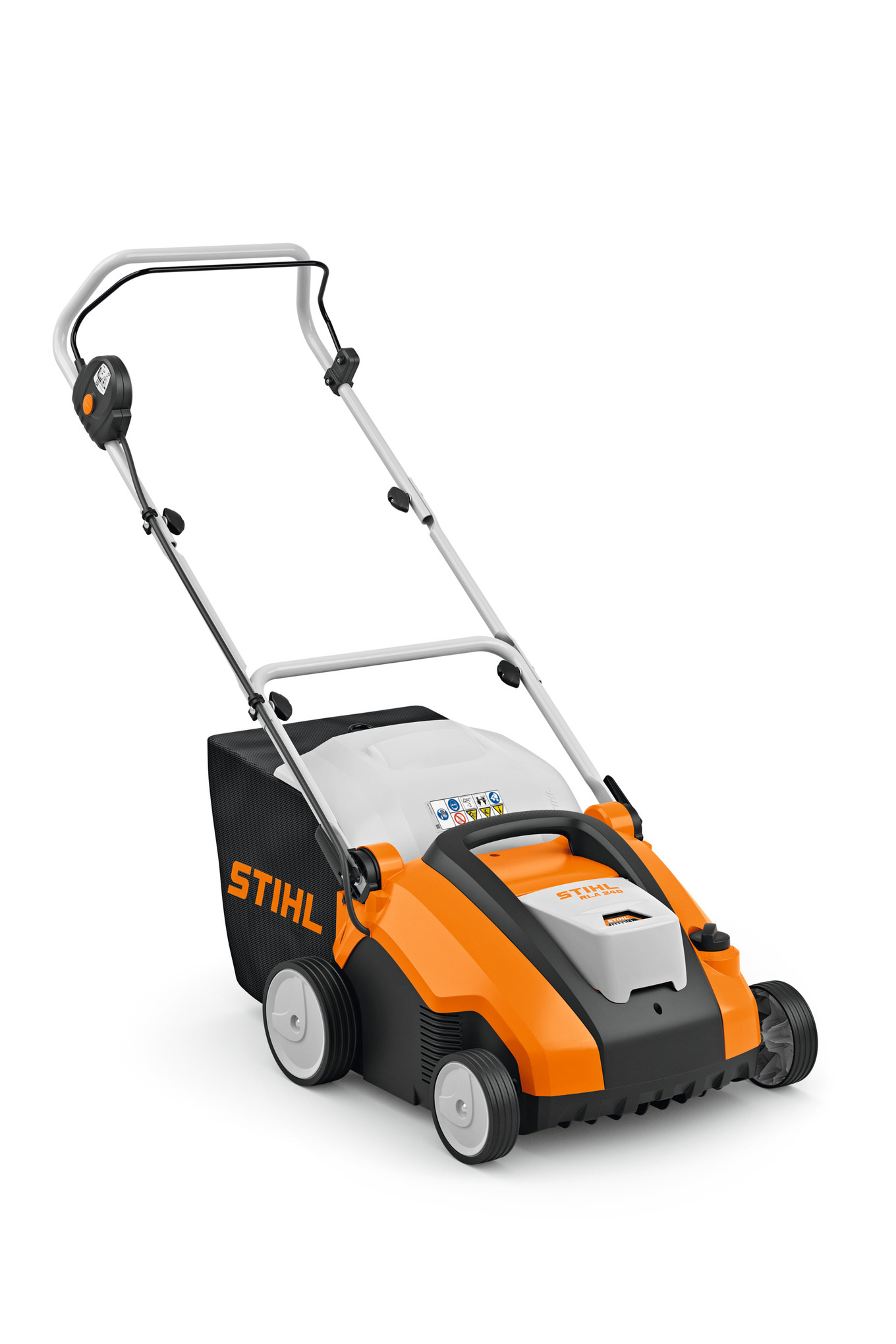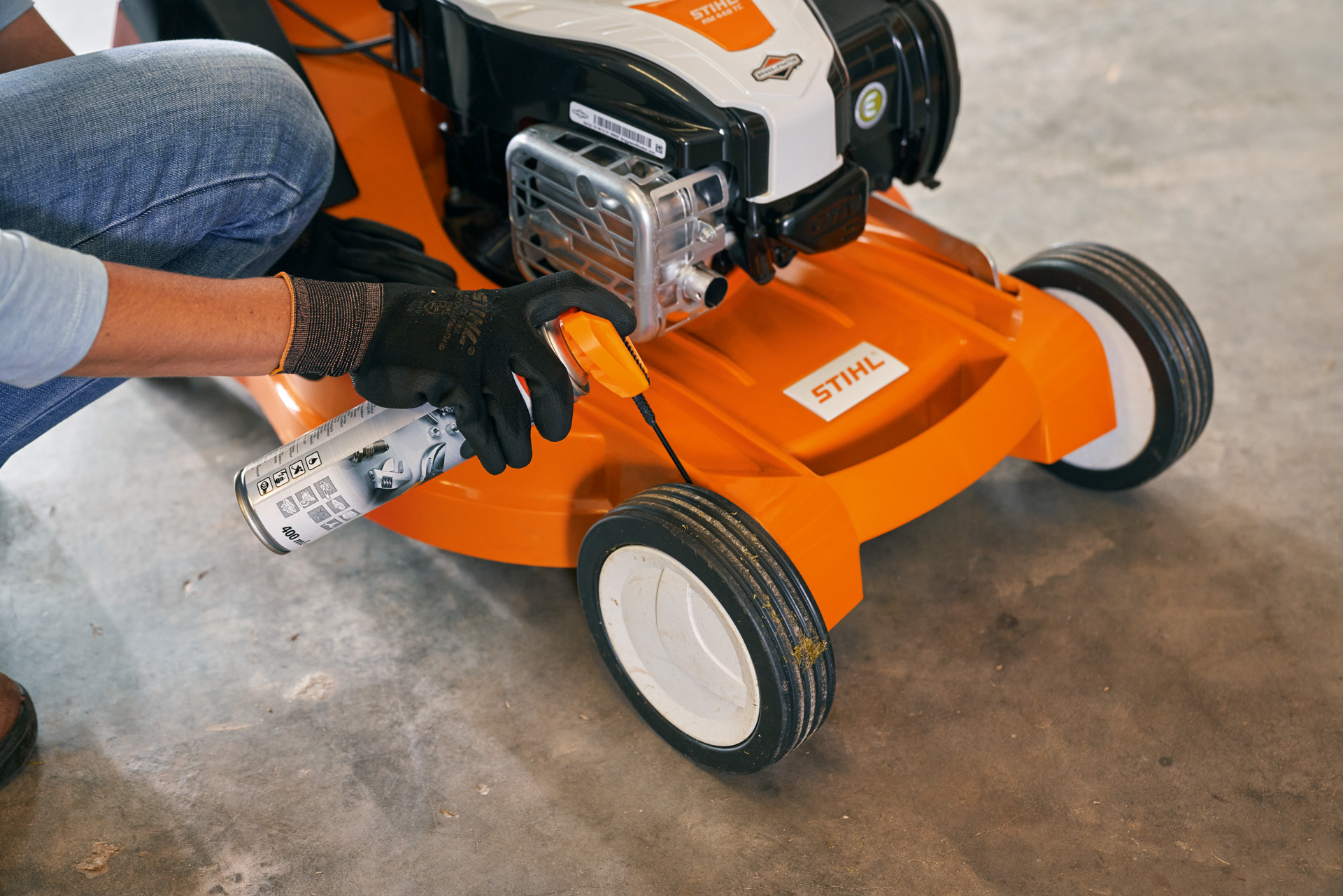Lawn care in spring
In spring, gardens start growing again, including lawns. Our spring lawn care guide tells you what you should focus on to get your grass looking its best.
13.07.2023

Clearing the lawn as the new season starts
In gardening terms, spring is the start of the new year. When it starts to get warmer, you know it’s time to start your spring grass care routine again; after all, that long snooze through the cold season means your lawn is hungry! But before you can fertilise it, it needs tidying up. That means raking to gather up all the leaves and broken twigs that have fallen on the lawn since it was last cleared. The amount of care you need to put into spring lawn maintenance also depends on its condition: is there moss and thatch? Does it contain a lot of dead grass? If so, it may not be enough to just mow your garden before the spring lawn feed – you may also need to scarify it.
How can I make my lawn look great?
The first step to achieving a healthy lawn is to completely clear it. Any leaves and twigs can be removed with a rake. If you're short on time, a STIHL leaf vacuum can help you get the job done quickly.
Level uneven soil
Once you’ve got the twigs and leaves out of the way, the next step is smoothing out any uneven ground – a straightforward spring lawn care task that just needs a shovel or a rake. Break up the soil on higher areas and spread it across the lawn; grass will grow through the bare patches again within a few weeks, or you can overseed the patches instead to fill them in.

Make sure the lawn is ready for mowing
The next spring lawn care job is to loosen the soil where necessary to prepare the lawn for mowing. The grass needs to be completely dry before you mow it, so if you see persistent standing water in places, it’s important to loosen the compacted soil in those spots so the water can drain away – just drive a fork into the ground a few times and move it around.
Spring lawn feed
If you did not mulch your lawn throughout the previous year, it is likely to be suffering from a lack of nutrients and will benefit from a spring lawn feed. Fertilisation in spring is part of good lawn care and helps the grass grow strong, healthy and green. It’s generally enough to fertilise the lawn twice a year – once in spring and once in late summer, though you may also opt for an extra round of fertilisation between those feeds, perhaps in June. Organic and mineral fertilisers are available in liquid, granular and soluble form from any garden care centre or DIY store. You will even find special spring fertilisers formulated to help the grass regenerate early and strengthen its weakened roots. This is also a great time to overseed any patchy lawns, as the fertiliser will support the new grass once it germinates – though we would recommend aerating and/or scarifying first for best results.
Fertilise your lawn to beat moss
Moss is an indicator plant for nitrogen levels, so it will spread quickly through your lawn if the soil is short of this nutrient in particular. Well-fertilised lawns suppress moss with vigorous grass growth, which is why including a spring feed in your lawn care schedule is a great long-term method for beating moss. However, if you’re dealing with a lawn that has been neglected to the point that the moss has almost completely overtaken the grass, the first stage of spring lawn treatment is to tackle the moss by scarifying the lawn. Then you can start fertilising it regularly to keep it in peak condition.
Spring lawn care: feeding tips
- After applying fertiliser according to the instructions, water the ground well to ensure that valuable nutrients are distributed throughout the soil.
- If there is a lot of moss and weeds in the grass, you should first scarify the lawn (though it’s best to wait until late April when it’s a bit warmer) and then apply a spring feed.
- A fertiliser spreader will give you even distribution over the lawn.

Lawn fertilising – step by step
Mowing the lawn in spring
As soon as conditions get warmer and the soil has reached around 10°C, you can start the spring lawn care schedule of mowing the lawn at least once a week, though we recommend mowing twice a week during peak growth periods. It needs its first cut of the year now to promote dense growth. Mid-March to mid-April is generally the best time to give the lawn its first cut – though a mild winter could mean the lawn needs mowing earlier in the year.
A clean cut: the first spring mowing of the lawn
The spring lawn is in a growing phase, so the next lawn care step is to make the first cut, known as the cleaning cut.
- Make sure that the blades on your lawn mower have been cleaned and sharpened. This means the soft, young spring growth is cut cleanly rather than being damaged in a way that makes the grass susceptible to disease. Blunt blades can easily rip grass rather than cutting it cleanly.
- Consider the length of your lawn. The optimum cutting height is between 4 and 6 centimetres; in shaded areas such as under bushes, it should be at least 5 centimetres.
- The central cutting height adjustment on STIHL lawn mowers makes it easy to set your preferred cutting height.

Give your lawn mower a spring inspection
- First, check your mower’s general condition, taking care to see there is no damage to the housing, wheels or blades.
- If the blades are blunt, visit your STIHL dealer to have them sharpened and balanced.
- For petrol-powered lawn mowers, change the oil in spring if you didn’t do it at the end of the last season. This lengthens the service life of the engine.
- You should also check the air filter of your lawn mower’s petrol engine: if it’s dirty or clogged, it needs replacing.
- With cordless lawn mowers, check the battery level and charge it fully before starting your spring lawn care.
Fertilise while you mow – in a single step
You can make lawn care even simpler by mowing and feeding your lawn in one go, using a STIHL mulch mower or the iMOW® robotic mower. These shred the grass clippings into small particles distributed across the lawn functioning as a natural green fertiliser. The nitrogen in the clippings is mineralised in the soil, which keeps your lawn nourished and happy.

Mulching lawns: mowing and fertilising in a single step
Mulch mowing is a natural lawn care method. Find out more about mulching in our mulching article.
Do I need to scarify my lawn?
Scarifying is simply the process of using a tool to clear matted grass and moss from the surface of your lawn, exposing the soil to improve growth. Whether you should include scarifying in your lawn care depends on your lawn’s condition. To check, pull a small metal rake gently through the turf before you start your spring lawn care: if it picks up old grass clippings, weeds or moss, this may show inhibited lawn growth. This is particularly common in heavy soils that are low in oxygen and become easily waterlogged; shade can also harm the structure of your lawn. Scarifiers with blades do a great job, or you can achieve similar results by putting some effort into careful raking of your lawn.
Tips for liming your lawn
You may wish to add a liming step to your lawn care list in spring to help avoid moss and matting the next year by adjusting the pH of your soil. You can buy a simple soil test to confirm your exact conditions; for grass, it should ideally be at a pH value of 6.0 to 7.0, with a lower value indicating acidity. Adding lime helps to alkalise the soil and regulate pH for the longer term, deterring moss and other lawn weeds in the process. Because lawn soils tend to become more acidic over time, applying lime annually in spring can be a valuable lawn care supplement until levels balance – after which it can be reduced to every few seasons. Mow and scarify first, then after applying lime, you should let the grass rest for at least a week.
Summary: lawn care in spring
- Remove leaves and twigs from your lawn in spring.
- Expose the soil surface using a rake, then leave it to dry.
- Aerate your soil to boost the circulation of air, nutrients and water to the roots of your lawn.
- Starting in March, complete the first cleaning cut.
- Mow regularly after the first cut, ideally weekly.
- Use specialist fertiliser for a spring lawn feed.
- Scarify your lawn to help prevent heavy matting and weeds. Add lime if your soil is very acidic.









